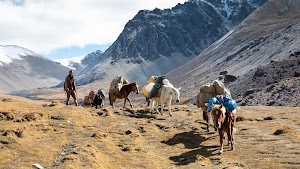Explore the Trans Bhutan Trail with Bhutan Inbound Tour: Book Now!
Walk, run, dance or play? What’s your style? Celebrate this awesome trans Bhutan trail in your style. The Trans Bhutan Trail was the only viable method to traverse Bhutan’s mountain kingdom until the 1960s but went out of usage after the coming of roads. With support from the Bhutan Canada Foundation and the Tourism Council of Bhutan, it was re-opened in 2021. Explore / Book Trans Bhutan Trail with the certified local agent: Bhutan Inbound Tour. Be the first few to venture into this unexplored trail. Book Now!

Background
The trail starts from Haa (West of Bhutan) & ends in Trashigang (The East of Bhutan). The trans-Bhutan Trail span 403 Km connecting villages & towns. The trail will take you through hidden forest cover, which is home to thousands of species of birds and some of the world’s most endangered animals.
Trans Bhutan runs across mountain ridges, dips into lush valleys, and connects dozens of towns and villages. Along the way, you will come across hundreds of historic and cultural sites including Dzongs, temples and ruins.

The trail is a mix of easy to moderate to one of the most challenging routes in the world. You can do parts or all of it.
If you are a nature lover, this trail is something you need to include in your Bhutan Tour. It’s a very rare opportunity to travel a millennium-old trail utilized by royals, monks, and commerce. And for 60 years it was under hibernation.
Trans Bhutan Trail Map
The below is the end to end Trans Bhutan Trail Map with average Kms and time taken.
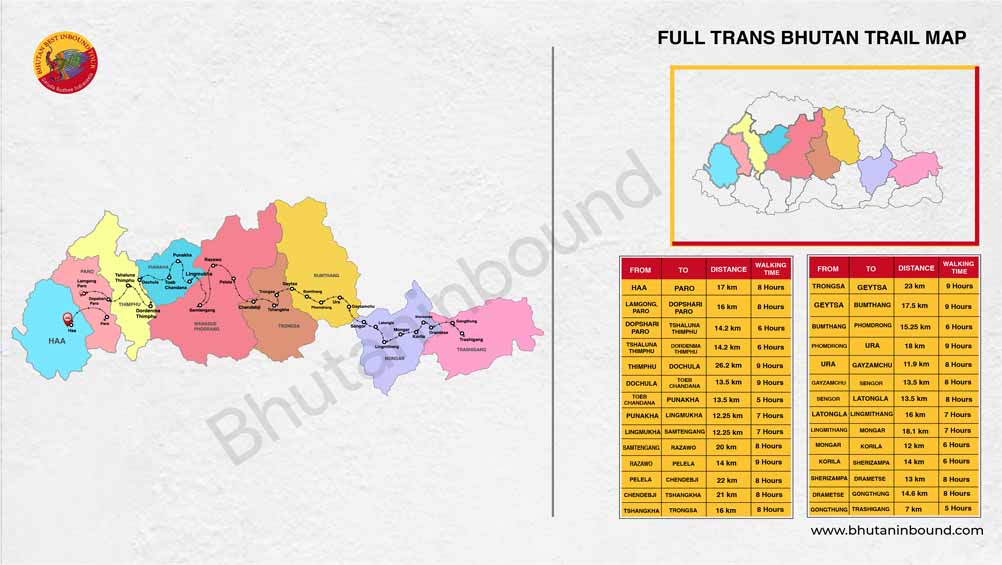
Trans Bhutan Trail is a 36-day tour & it can show the world what it’s been missing. We can understand that 36 days is little too much but to get a feel of it you can do it in parts. You can choose to do it for a day, few days or for 36 days at a stretch.
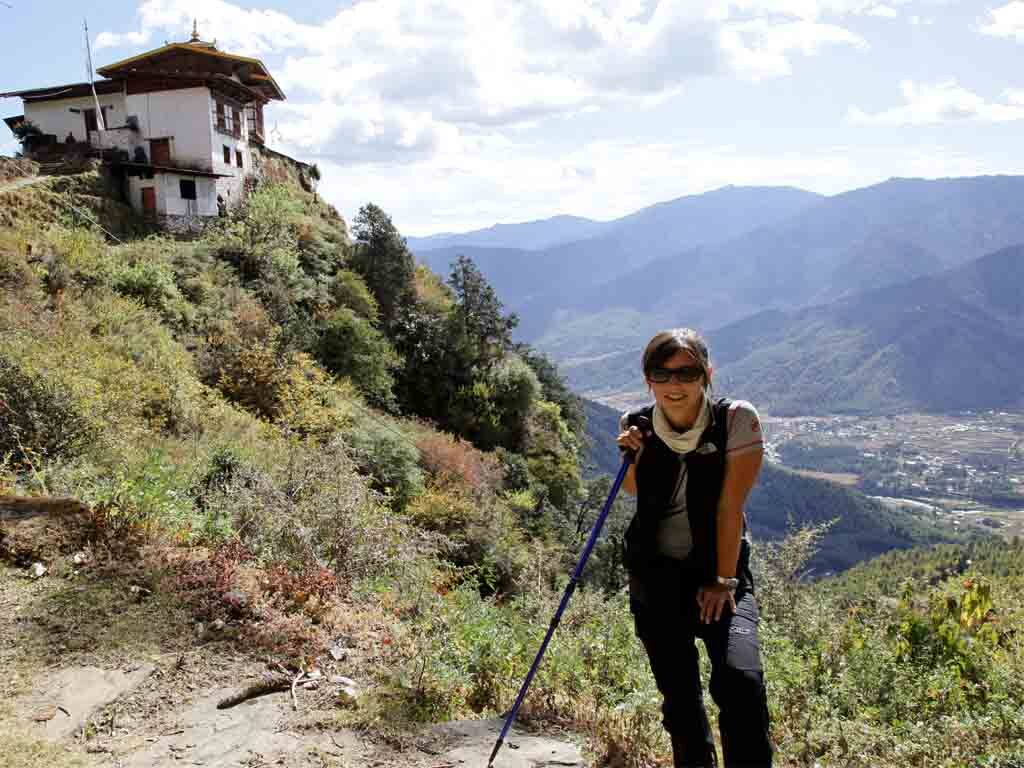
Even the part of trail can give you the glimpse of timeless settlements from another time. The beauty of this trail is it includes part of Sagala Trek, Samtengang trek & Druk Path trek.
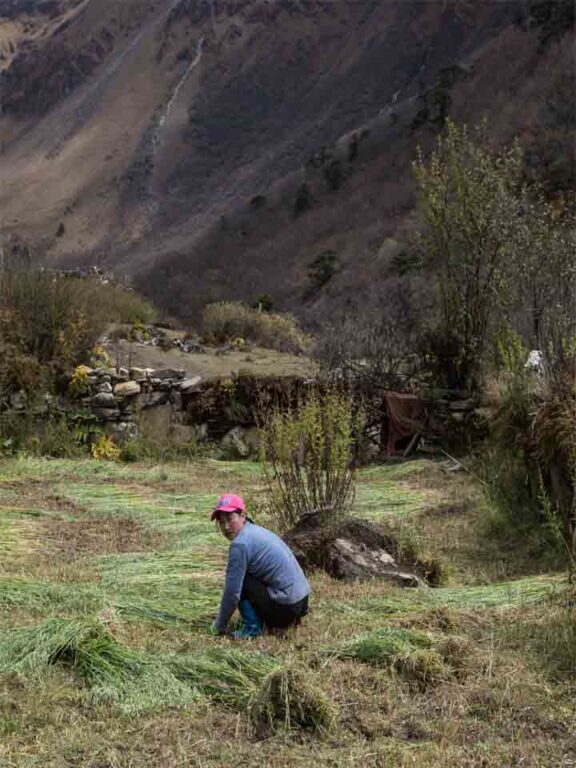
Under the ‘Trans Bhutan Trail’ project, amenities such as toilets and resting areas are being installed along the route. To guide hikers and to provide history about a certain place, around 130 sustainable marker poles with a QR Code is available along the entire trail.
So, if you scan the marker pole , you will get detailed information about the place. There are around 130 poles in places such as Chendebjii and Zhonggar Dzong. The poles is installed starting from Haa to Trashigang.
This journey, will provide insight into Bhutan’s rural and spiritual life that it can only obtain by venturing off the main road. So lace up your trekking boots – the Trans Bhutan Trail is waiting for you. Pick your style
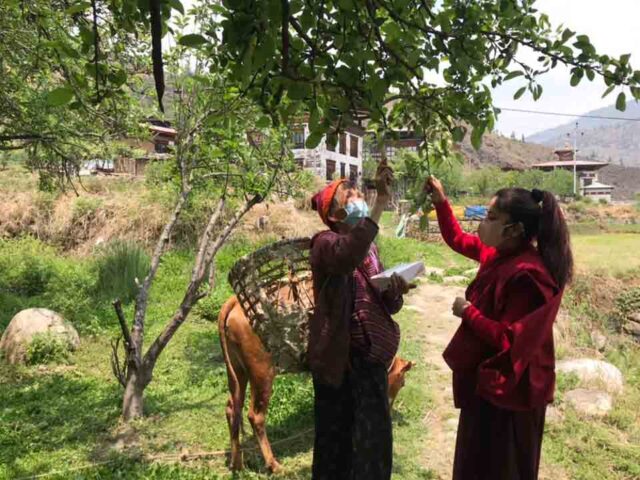
Section / Glimpse of Trans Bhutan Trail Paro Video
Trans Bhutan Trail Itinerary
Shorter & of Moderate Activity Level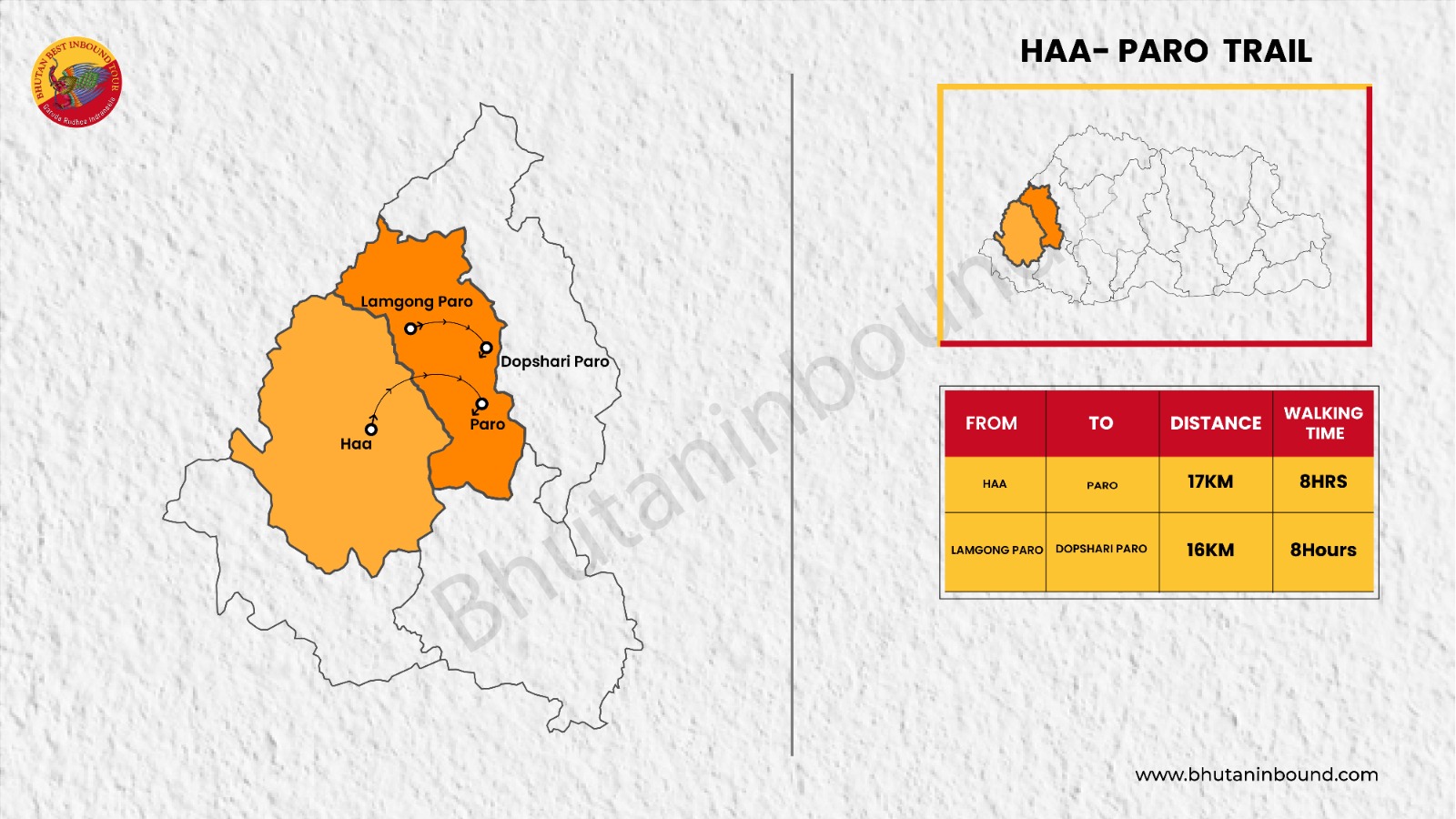
Haa- Paro 17Km / 8hrs ( Trail Start Point: Kasho village at Haa; Trail End Point: Kyichu at Paro)
Lamgong, Paro –Dopshari Paro 16Km / 8Hours (Starting Point: Lamgong Village, Paro;End Point: Dopsari, Paro)
Maximum Elevation: 3,790 m
Activity Level : Moderate / Short Trek
Total: 33 Km
Description:
Take a two-day journey through the Haa to Paro Valley while ascending the Trans Bhutan Trail in the direction of Dopshari if you love trekking.
This route was used by the people of Paro & Haa mainly for trading purpose when the barter system was prevalent. Parops used to barter their local rice with dry meat from Haa. Haa being at higher elevation the growing of rice is not feasible.
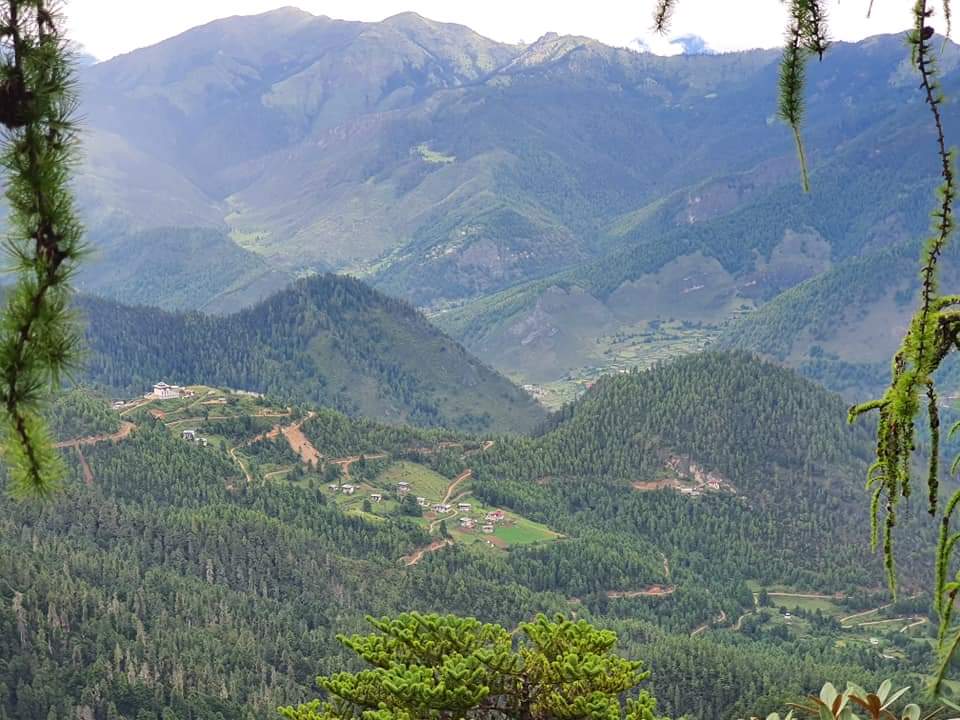
Tour Highlight
- Enjoy the panoramic view of Haa & Paro Valley
- Visit ancient temples like Kyichu Lhakhang, built in 7th century
- Savor Bhutanese local food delicacies
- Interact with locals
- Treat yourself with stunning views of Himalayan range ( Mount Jichu Drake(6794m)/Mount Jomolhari (7314m) & Mount Tsheringma (6789m)
- Enjoy the picnic lunch on the hill top.
- Take a forest bath through rhododendron & bamboo forest
- Traverse through traditional Bhutanese farming villages
- Enjoy a colorful kaleidoscope of golden mustard fields, rooftops spread with drying bright red chilies, neat whitewashed homes tucked away on terraced rice and buckwheat patches, and high passes marked by masses of fluttering prayer flags.
- Experience the lesser traveled areas of Bhutan
- Capture the heart & soul of Bhutan at Dopsari village
- Learn the art of preparing Bhutanese Cuisine, Suja
- Share HAPPINESS with the locals
- Visit the National Museum ( Ta Dzong), and catch the glimpse of Bhutan in the last 100 years
- Visit the castle-like Paro Dzong, the finest example of Bhutanese architecture
- Take Part in local Activities
- Visit Paro Dzong
- Take Part in local Activities- local archery game & Khuru
- Rejuvenate in traditional hot stone bath
- Enjoy Panoramic vistas of Paro valley
Check Out the detailed itinerary here
https://www.bhutaninbound.com/trekking-in-bhutan/western-trans-bhutan-trail-moderate
2. Longer & Challenging Trans Bhutan Trail
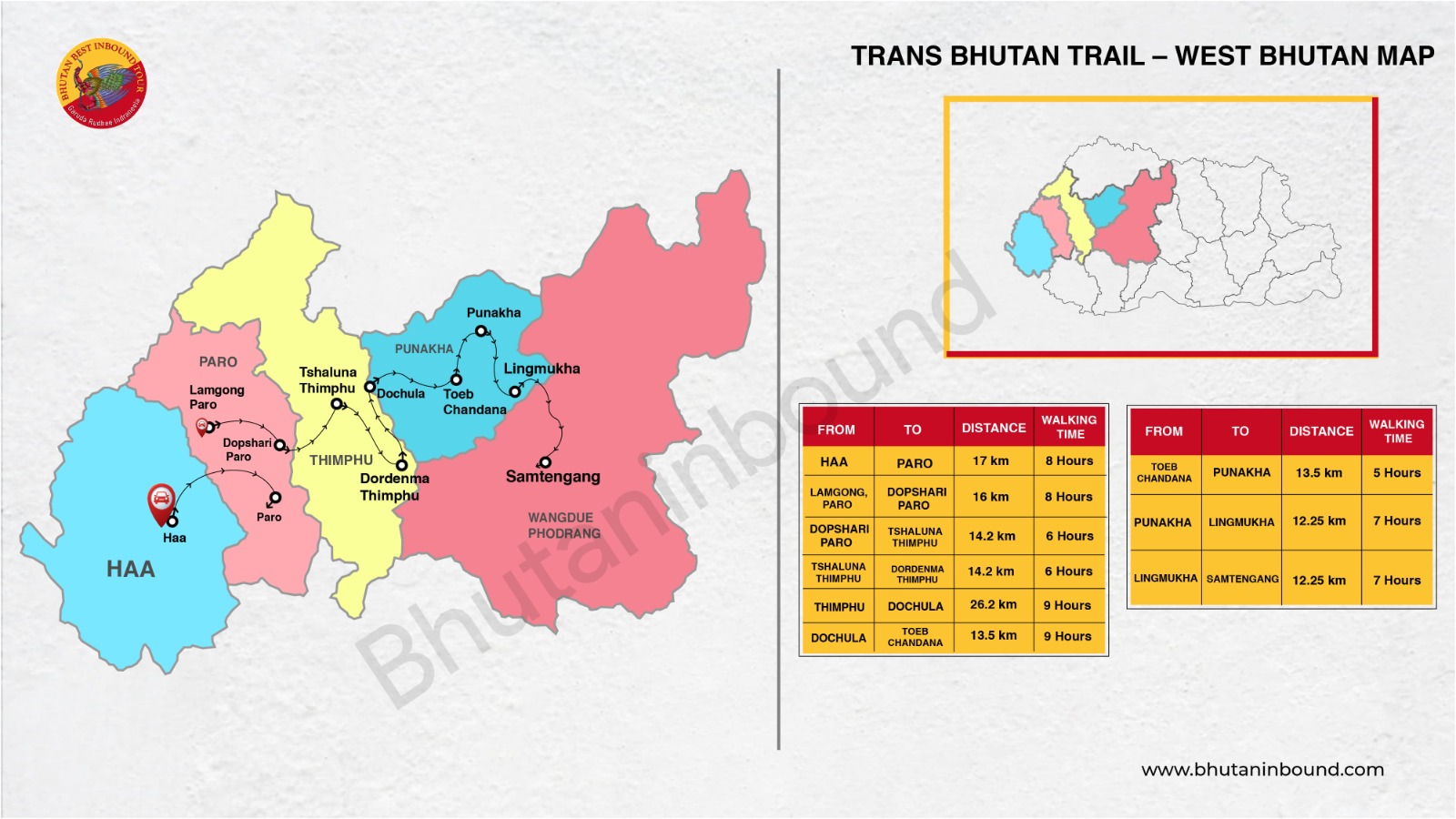
Description:
It takes about two weeks to complete this trek. This trail allows you to retrace the Bhutanese ancestors’ steps and re-discover generations’ worth of stories and history. The Trail also serves to promote the fundamental values of the Kingdom with regard to the environment and sustainable development. In the trekking points, there are various spots. We have mentioned the spots and the dimension here:
- Haa to Paro takes 17Km / 8hrs
- Lamgong, Paro to Dopshari Paro requires 16Km / 8hours
- Dopshari,Paro to Tshaluna Thimphu needs 14.2Km/ 6 hours
- Tsaluna Thimphu to Dordenma Thimphu takes 14.2Km/6hours
- Thimphu to Dochula requires 26.2 / 9 hours
- Dochula to Toeb Chandana takes 13.5 Km/ 9 hours
- Toeb Chandana to Punakha needs 13.5 Km/ 5 hours
- Punakha to Lingmukha takes 12.25 Km /7 hours
- Lingmukha to Samtengang takes 12.25 Km/7 hours
Check Out the detailed trans Bhutan Trail itinerary here
https://www.bhutaninbound.com/trekking-in-bhutan/trans-bhutan-trek-challenging
3. Easy Central Bhutan Trans Bhutan Trail
On this 9-day journey hike , discover central and western Bhutan. On this tour led by our guide, you will get the opportunity to explore historic temples, taste traditional Bhutanese Culture, see village ways of life & also walk through the famous Trans Bhutan Trail.
This is an easy 9 days trans Bhutan trail itinerary which can be done even by the tourist who have come for cultural tour. Each day we will be just be doing 1-2 hours of portion of trans Bhutan Trail.
Check Out the detailed trans Bhutan Trail itinerary here
THE DETAILED SECTION OF WEST BHUTAN -TRANS BHUTAN TRAIL
The below are the list of popular trans Bhutan trail
1. Trek from Haa to Paro (1 Day Trek)
Trek Distance: Approx. 17 kilometres
Estimated Trek Duration: 8-9 hours
Highest Elevation:3790 m
Trail Start Point: Kasho village at Haa
Trail End Point: Kyichu at Paro
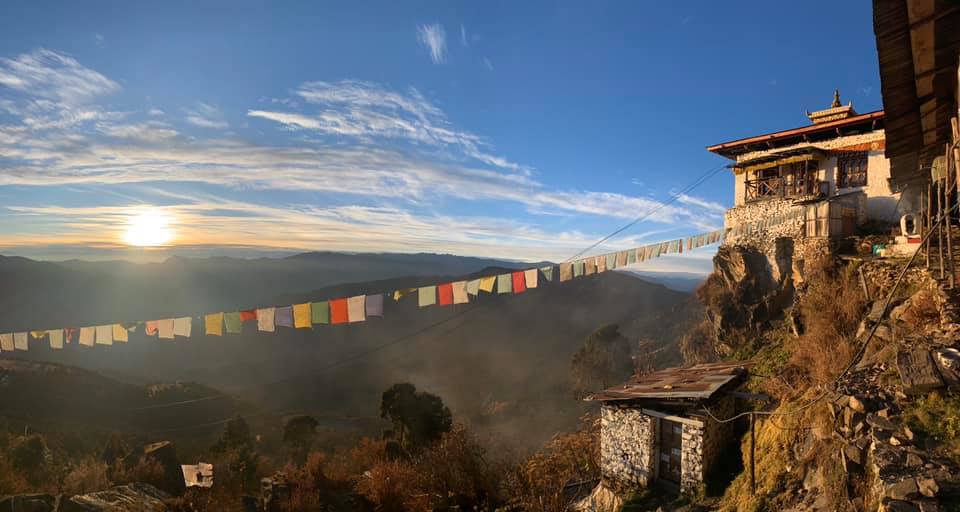
Activity Level: Moderate
Back Ground
This route was used by the people of Paro & Haa mainly for trading purpose when the barter system was prevalent. Parops used to barter their local rice with dry meat from Haa. Haa being at higher elevation the growing of rice is not feasible.
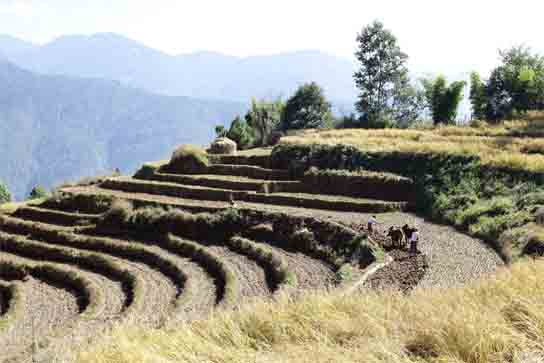
-Enjoy a colorful kaleidoscope of golden mustard fields, rooftops spread with drying bright red chilies, neat whitewashed homes tucked away on terraced rice and buckwheat patches, and high passes marked by masses of fluttering prayer flags.
2. Hike Through Lamgong Village to Dopsari-Paro
Trek Distance: 16 kilometres
Estimated Trek Duration: 6-8 hours
Highest Elevation:2826m
Starting Point: Lamgong Village, Paro
End Point: Dopsari, Paro
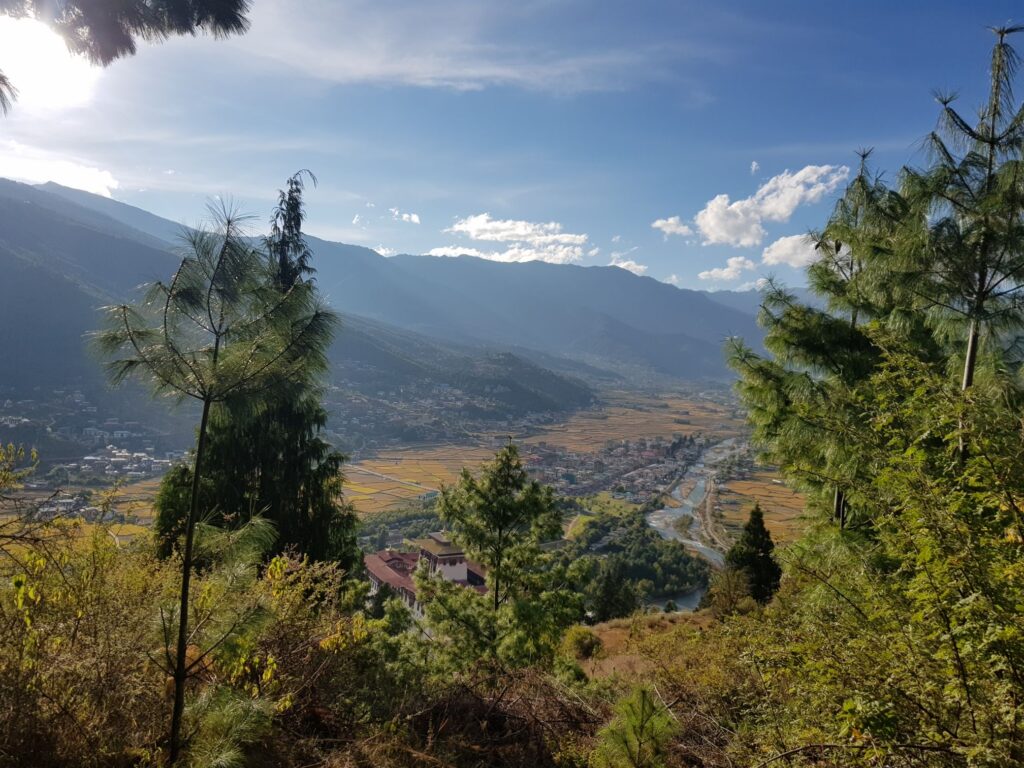
Activity Level: Moderate
Tour Highlight
- Experience the lesser traveled areas of Bhutan
- Capture the heart & soul of Bhutan at Dopsari village
- Learn the art of preparing Bhutanese Cuisine, Suja
- Share HAPPINESS with the locals
- Visit the National Museum ( Ta Dzong), and catch the glimpse of Bhutan in the last 100 years
- Visit the castle-like Paro Dzong, the finest example of Bhutanese architecture
- Take Part in local Activities
- Visit Paro Dzong
- Take Part in local Activities- local archery game & Khuru
- Rejuvenate in traditional hot stone bath
- Enjoy Panoramic vistas of Paro valley
3.Walk to the village of Debsi – 3km/2 miles, 1½ hours walking. (Thimphu)
This is perhaps the shortest section of Trans Bhutan Trail.
Drive upto Buddha Dordenma statue which sits high above the town and offers excellent views across the Thimphu Valley. From the statue you descend into the Debsi Valley and eventually to the small village of Debsi. You will be walking through the forest of pines & if lucky you may spot Kahlil Pheasant & Mac Pie birds. The trail ends with a small feeder road before crossing a bridge that leads to the highway.
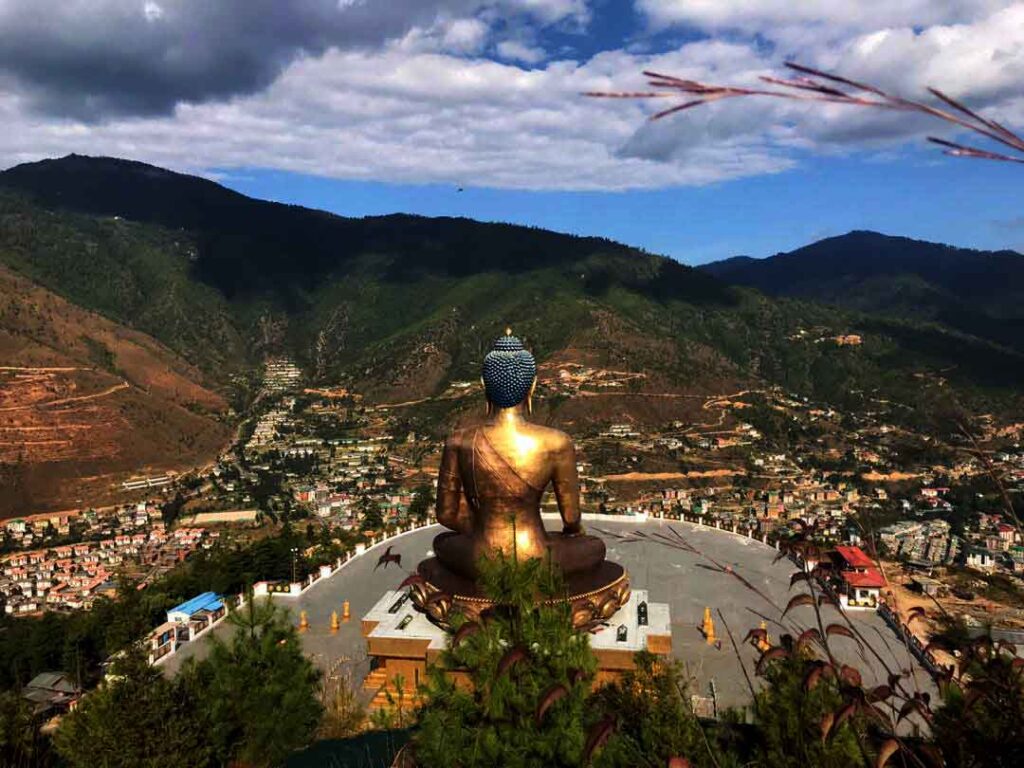
4. Walk the Trans Bhutan Trail to Toeb Chandana (Section of Divine Madman Trail), 1,560m 13.7km
Drive towards Dochu La Pass, 3,140m/10,302ft. The pass is marked by a collection of 108 chortens which were built in 2005 and make for a very impressive and photogenic sight.
From here you can also get panoramic views of the eastern Himalayas. On a clear day, you can even see Bhutan’s highest mountain, Gangkar Punsum, 7,550m/24,770ft. This still remains the highest unclimbed mountain in the world.
From the Dochu La, the trail descends gradually through conifer and warm broadleaf forest. The area is home to many species of birds and mammals including the red panda – although you would be very fortunate to see one. You pass through several villages and pretty rice terraces with the path undulating but mainly descending. The temple of Thinleygang Lhakhang, now a school for young monks, makes a good place to stop for refreshments before continuing lower into the valley past farms and across a suspension bridge to reach Toeb Chandana.
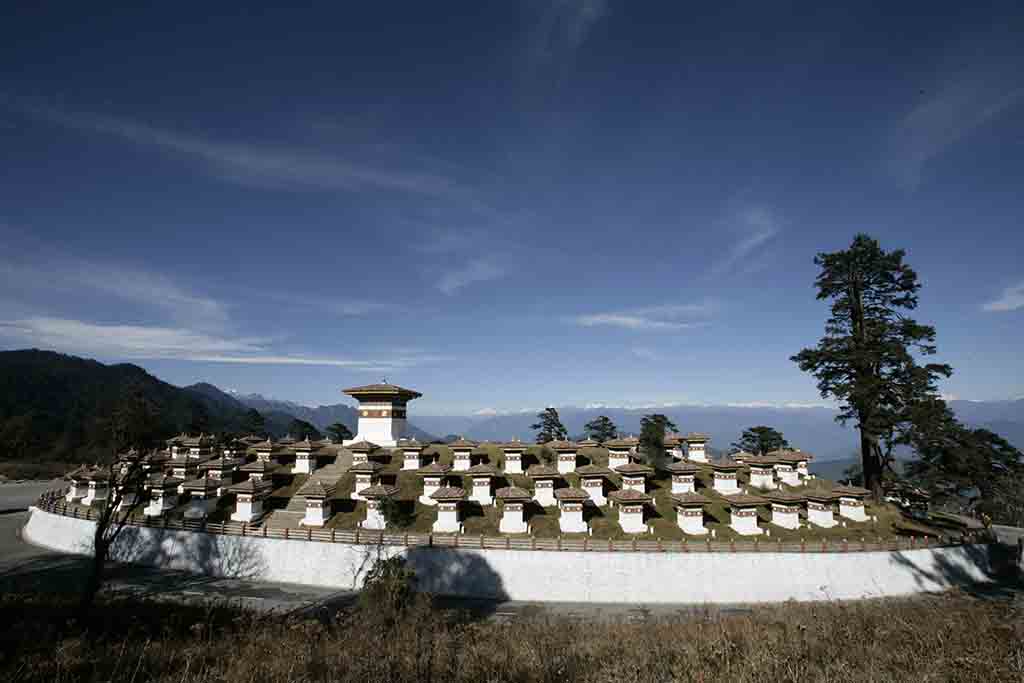
This spot plays an important role in the legend of the Divine Madman as it is said that Drukpa Kunley fired an arrow from Tibet to decide the course of his journey and the arrow purportedly landed on the house here. You can climb the steps to have a look inside the house and also visit the Chandana Lakhang next door which was built to mark the sacred spot and to ward off an evil demon. The murals inside the temple depict the tale.
5. Punakha – Limukha-Chhungsakha (12kms/4 hours Trekking)
After passing majestic Punakha Dzong you cross a footbridge over the Pho Chhu and walk up to Shengana. This is the longest bridge in Bhutan. You then climb gradually through the forest until you reach Limukha. Make sure you are carrying enough water as you won’t find any on the way to Limukha.
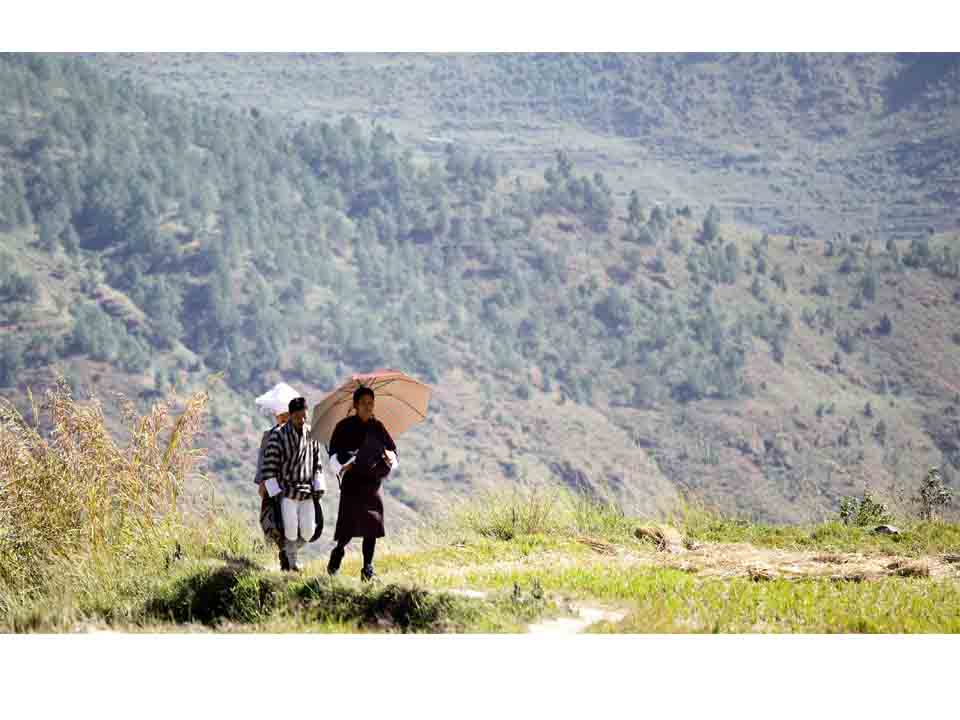
The path leads through rhododendron and oak forests to Chhungsakha. Chungsakha is a small village of about 10 houses. You’ll find a holy stone and an impressive Cyprus tree here that are reminders of DrukpaKuenley, the “divine madman”.
6. Chhungsakha – Samtengang (13kms/5hours Trekking)
Elevation at Campsite: 1,830 meters
You walk downhill until you cross Pe Chhu before climbing again through the village of Sha on your way to Samtengang. Near the school in Samtengang you will see a small lake and your campsite is right next to it.
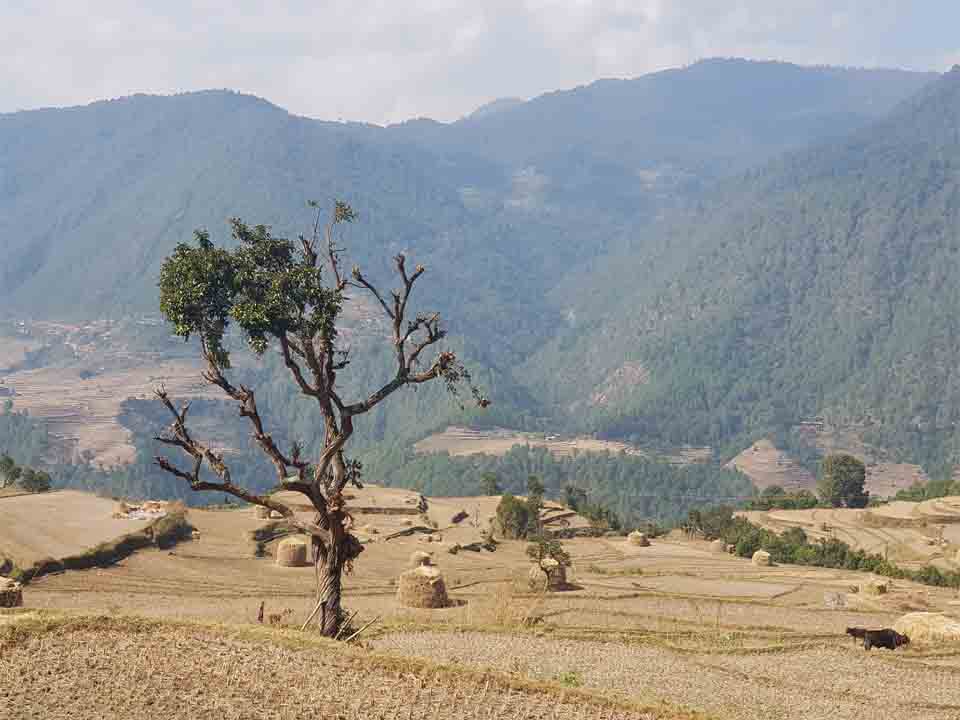
7.Samtengang – Razawo
The Trail begins with an elevation as you leave Samtengang and then flattens out before ending the day with a drop toward Razawo. After that, set off on a portion of the Trail with tremendous historical significance and was originally traveled by the renowned messenger Garp Lunghi Khorlo and the renowned Chamberlin Pemi Tshewang Tashi. Additionally, it is remote without any populated areas, allowing you to spend the entire day in harmony with nature.
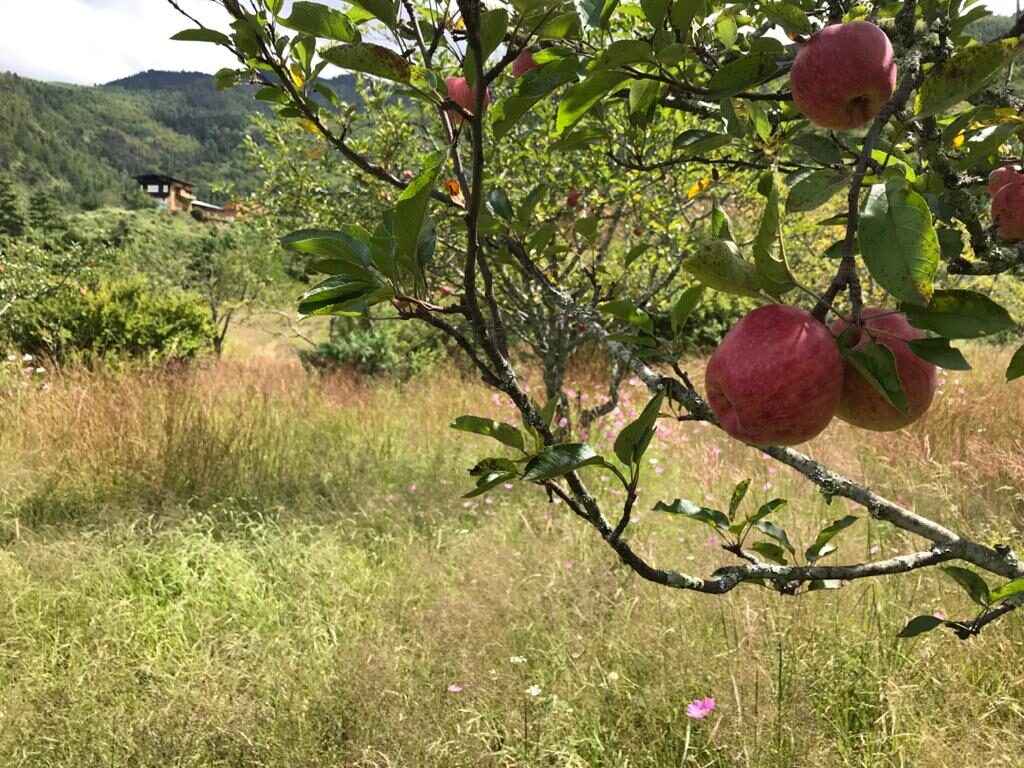
Visit the Chorten (stupa) in Razawo, one of the oldest in Bhutan and is believed to have been constructed during Buddha Kashyapa.
After seeing the chorten, return to your campground, where you may unwind with a hot shower and a hot stone bath. We’ll serve a supper made using organic, nearby-sourced ingredients.
7.Punakha-Pelela-Rukubji-Gangtey
Trek Distance: 10 kilometres (6.21 miles)
Estimated Trek Duration: 3.5 hours
Maximum Elevation: 3,402 metres
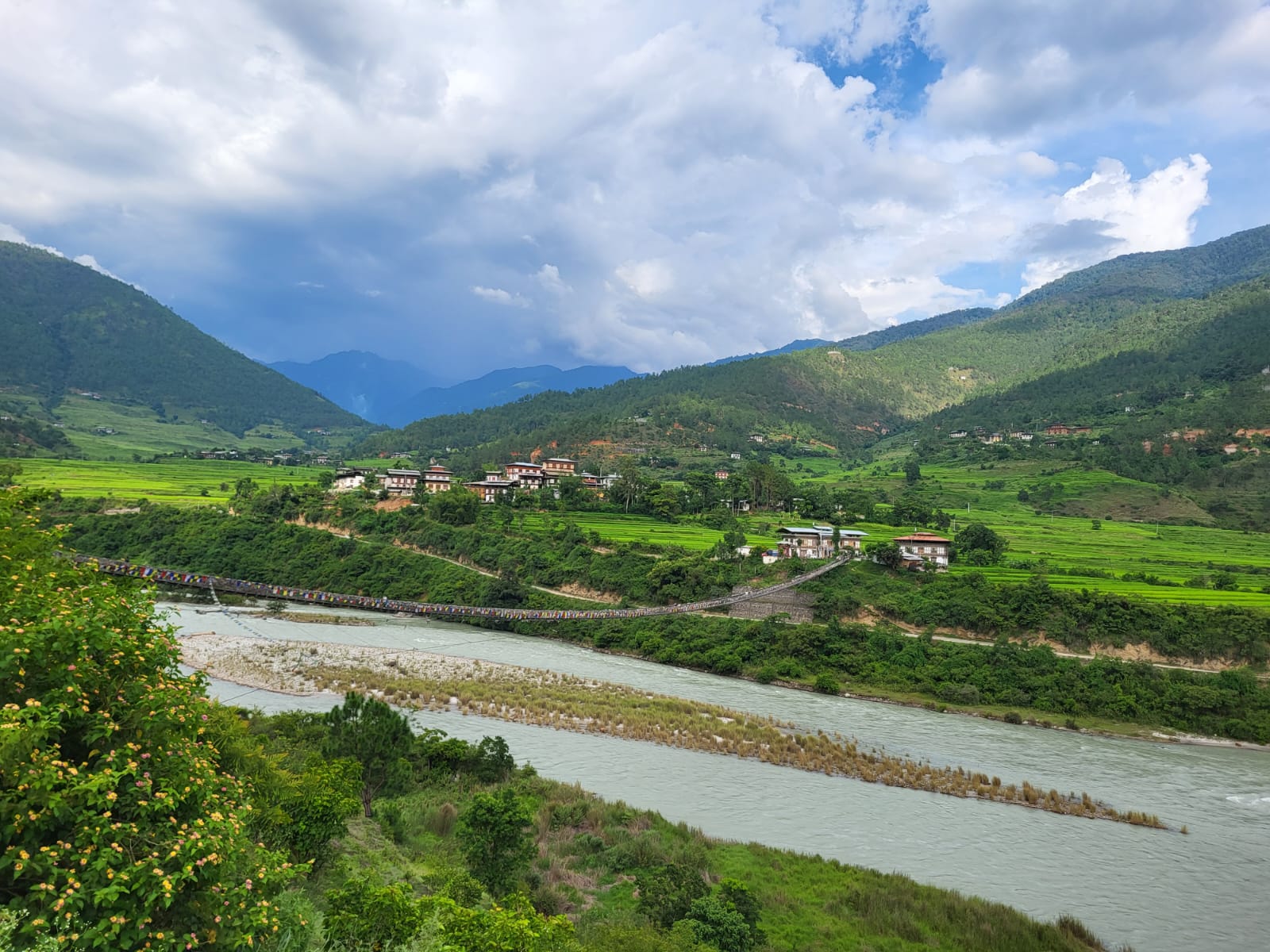
Highlight
-Drive towards Pelela Pass: at 3,407 m above sea level, the Pelela Pass is one of Bhutan’s highest pass
-At Pelela join the Trans Bhutan Trail heading east
– Traverse through the forest of pine & rhododendron
– Chat with yak herders on the trail
-Stop at Rukubji -Taste local food, meet local people and listen to the local folklore
Stop at Rukubji’s village Lhakhang (temple), also known as Kuenzang Choling.
-Feel the serenity of the hike
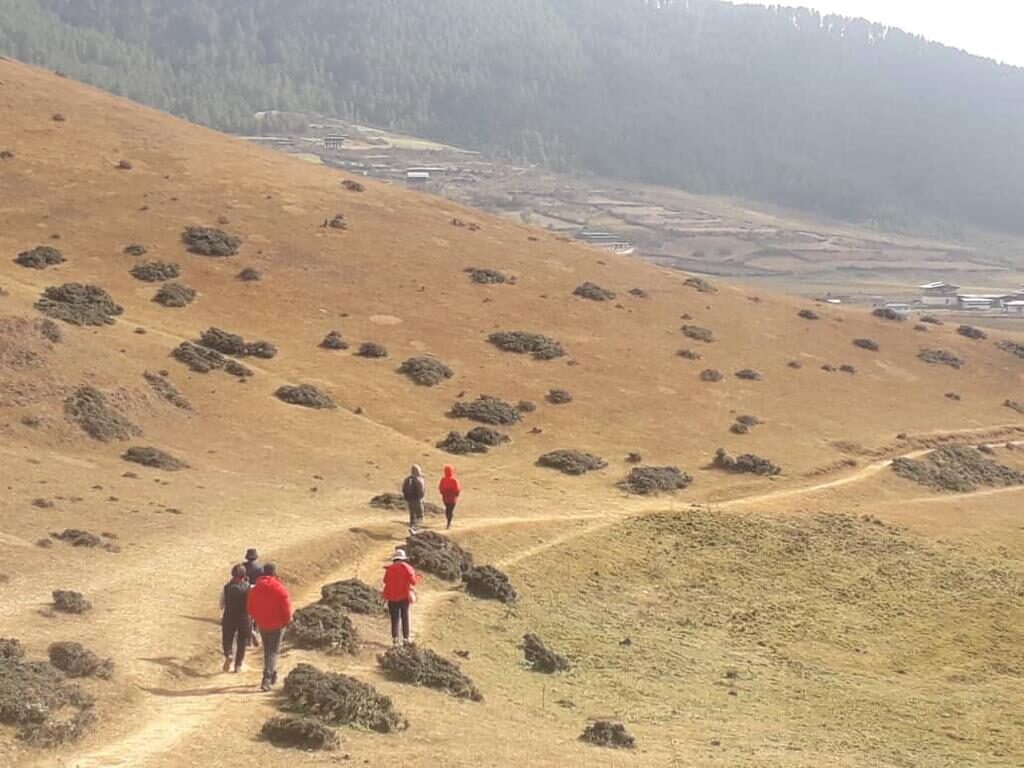
CENTRAL BHUTAN- TRANS BHUTAN TRAIL
Chendebji – Tshangkha
At the Chendebji Chorten, after breakfast at your camp, re-join the Trail (stupa). After briefly traveling along the former East-West National Highway, you will turn back into the middle of the countryside. And from here go to the settlement of Tangsiji. A Tangsiji farmhouse will serve a cooked lunch.
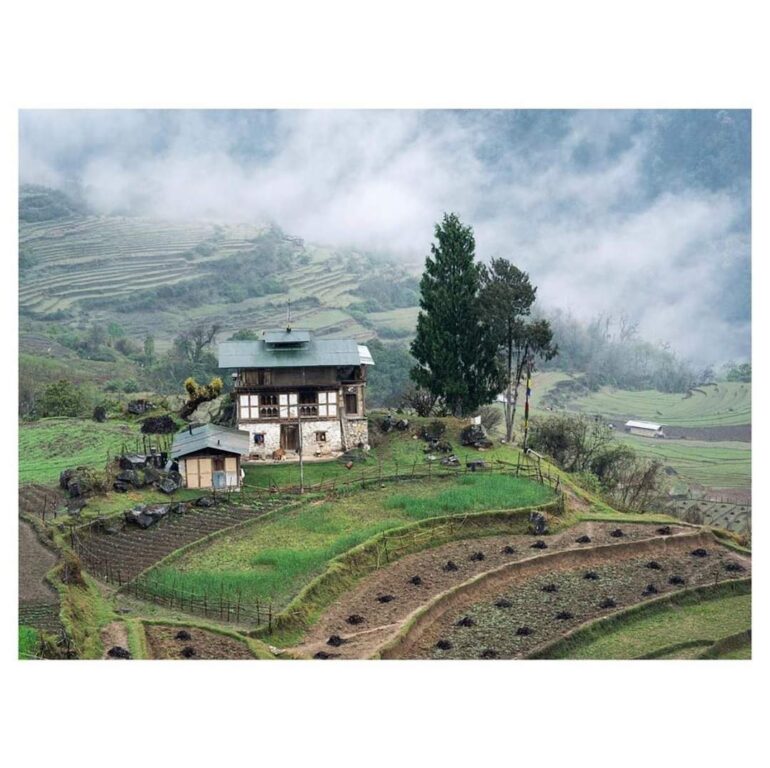
Hydropower plant sites are located along the Trail’s current course. In 2009, Bhutan became the only carbon-negative nation in the world, partly thanks to these clean, renewable energy initiatives. Bhutan also sends a lot of clean energy to its neighbor, India.
In Trashiling village, you will also get the opportunity to see the Trashichoeling Lhakhang (temple). His Holiness, the 70th Je Khenpo, donated the land for the temple in 2002 as a gift for His Majesty the Fourth King of Bhutan.
Upon arrival, visit the Tshangkha Lhakhang (temple) before proceeding to your campsite. The first building was erected here in 1701 by Choezang, the Trongsa Chamberlain, and the location presently serves as a place for community gatherings for social and religious reasons. It is believed that Lopen Golay of Tshangkha, who derived his knowledge and strength from the mantras of the Mindroling monastery in Tibet, first blessed the temple site on an unspecified date.
Enjoy a hot shower, a hot stone bath, and an organic meal at the campsite after your journey.
Tshangkha-Trongsa
Return to the Trail for the short, steep ascent out of Tshangkha after breakfast at your tent, passing the Ugyen Choling and Tsangkha Sheydra. Returning to the National Highway, which crosses at the Trongsa viewpoint, the Trail descends once more.
Since the first two hereditary Kings of Bhutan ruled from the Trongsa Dzong (fortress), which serves as the country’s geographic center, Trongsa is also closely associated with the Bhutanese Royal Family. The crown prince traditionally serves as Trongsa’s Penlop (Governor) before ascending to the throne.
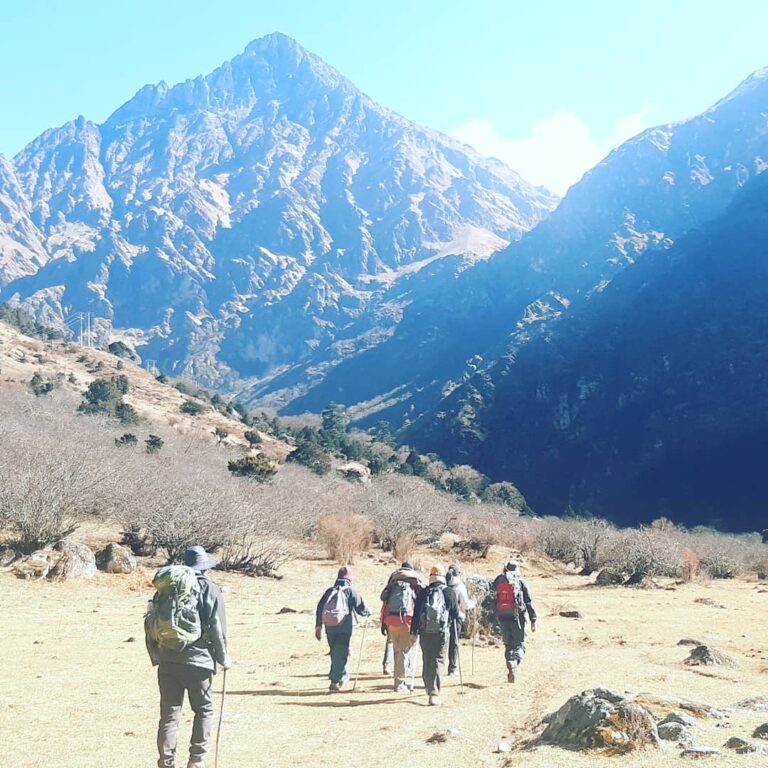
Centuries ago, the Trans Bhutan Trail would have gone straight through Trongsa Dzong, which is still where it crosses the center of the city today. As you descend into the narrow valley below the viewpoint and take in the breathtaking views of the Dzong (fortress) on the other side, you will experience what it was like for the garps (messengers) of long ago to travel to this mighty city on foot. You will pass the old cantilever bridge over the Mangde River at the foot of the valley before climbing the opposite side and approaching Trongsa Dzong (fortress) through the Western gate.
Trongsa Dzong
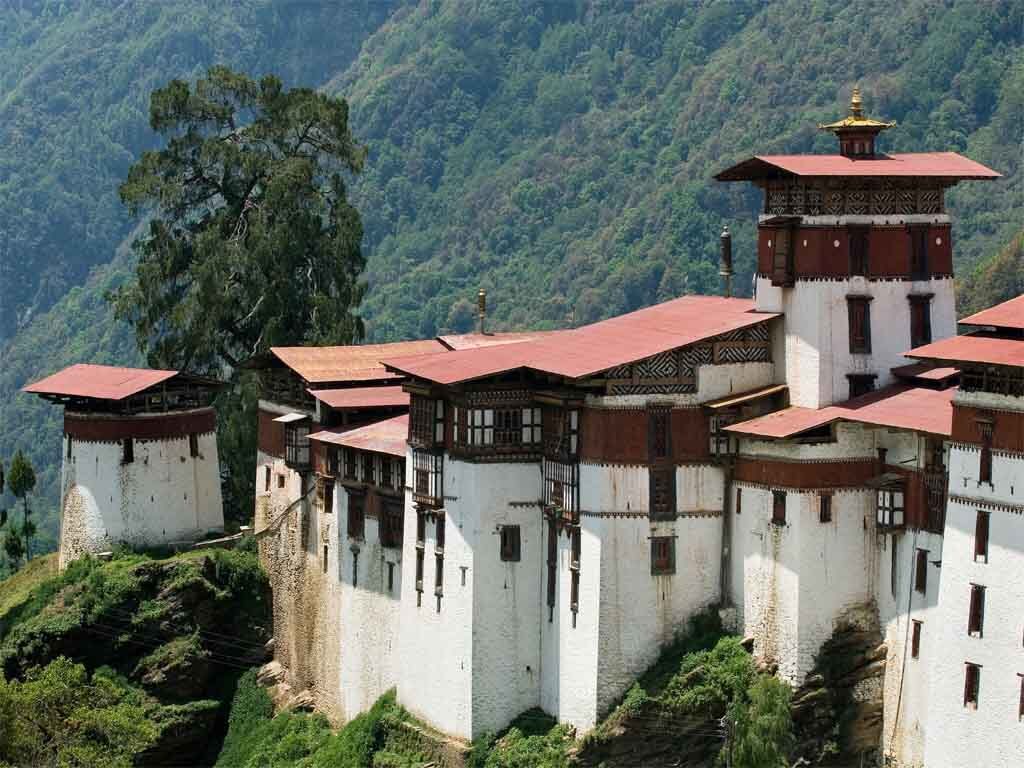
Enjoy a Trongsa Dzong (fortress) tour following lunch at a nearby eatery. Ngagi Wangchuck first constructed Trongsa Dzong as a tiny meditation room in 1541 after discovering the self-manifested hoofprints of the god Pelden Lhamo nearby. Around the location, Trongsa, which in the local tongue means “new village,” quickly grew. The Dzong (fortress) was originally constructed in 1644, and at the end of the 17th century, it again expanded. Around 450 district monks reside there; they spend the winters in Trongsa and the summers in Bumthang.
Before going to the fascinating Royal Heritage Museum, which is presently housed in the Trongsa Ta Dzong (watchtower), you will tour a few of the Dzong’s 23 lhakhangs (temples).
Before having dinner with your guide at a nearby restaurant in the early evening, you will have the rest of the day to yourself to unwind.
Phomdrong – Ura
Rejoin the Trail after breakfast and move in the direction of Ura. The Trail briefly travels along the former East-West thoroughfare before turning back into the rolling countryside and going through buckwheat fields.
Before beginning the switchback climb to the Sheytangla Chorten (stupa), take in a picnic lunch close to the settlement of Tangsiji. From here, you’ll get mesmerizing views over the Ura valley. After leaving the chorten, head into the Valley in the direction of Ura, where you will set up the tent for the evening. Enjoy a hot shower, a stone bath, and a locally sourced organic meal when you arrive at the campsite.
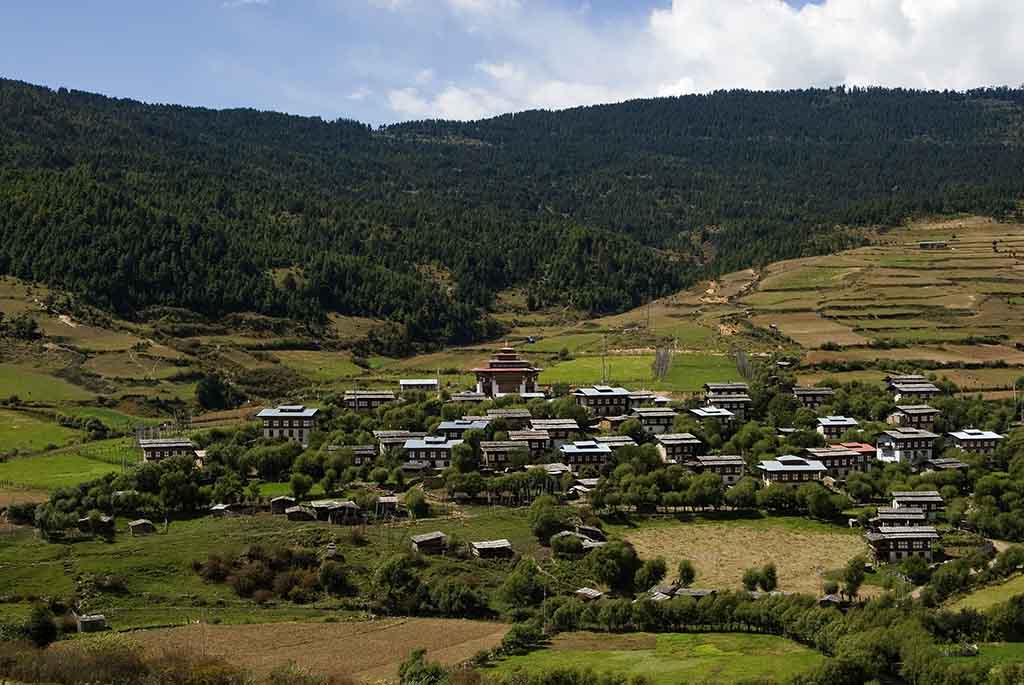
Ura – Gayzamchu
Leave for a tour of the Ura Lhakhang after breakfast (temple). Its primary statue, a two-story Guru, was constructed in 1982. Locals claim that another human-sized copper Guru kept in the temple was the one who once prevented the Valley from becoming infected with chronic leprosy.
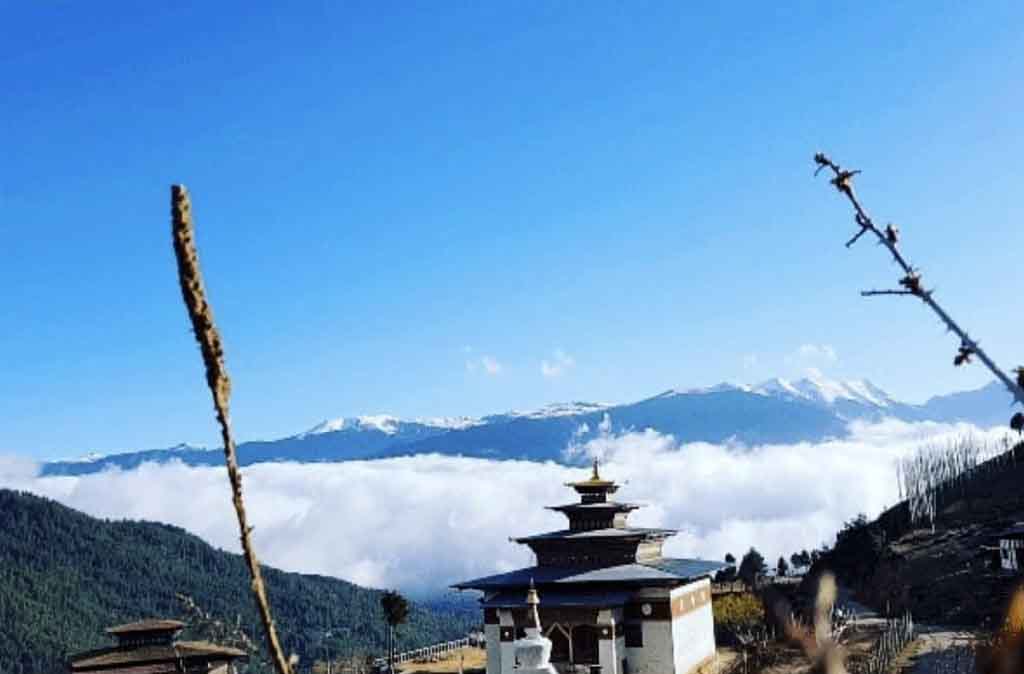
Following your visit to the temple, carry on your hike through the lovely Ura Valley as you ascend to the Wangthang La Pass. It is one of the highest places on the Trans Bhutan Trail, rising to 3,775 meters (12,385 ft) above sea level. This challenging part goes through the gorgeously magnificent Phrumsengla National Park, a sizable wildlife reserve where red pandas, tigers, and uncommon fauna find refuge in mountain ranges covered in trees. After enjoying a picnic lunch, head south toward Gayzamchu, where you’ll spend the night camping.
Enjoy a hot shower, a stone bath, and a locally sourced organic meal when you arrive at the campsite.
Eastern Bhutan-Trans Bhutan Trail
Gayzamchu – Sengor
A difficult day of trekking up through the Phrumsengla National Park in the direction of the Thrimshingla Pass begins after breakfast at camp. After a picnic lunch, go from Thrimshingla to Sengor, where you can take in breathtaking valley views while navigating through thick woodland and past herders’ camps. The Trail ascends through rhododendron forests as it leaves Gayzamchu; as you walk, watch the elusive and endangered red panda.
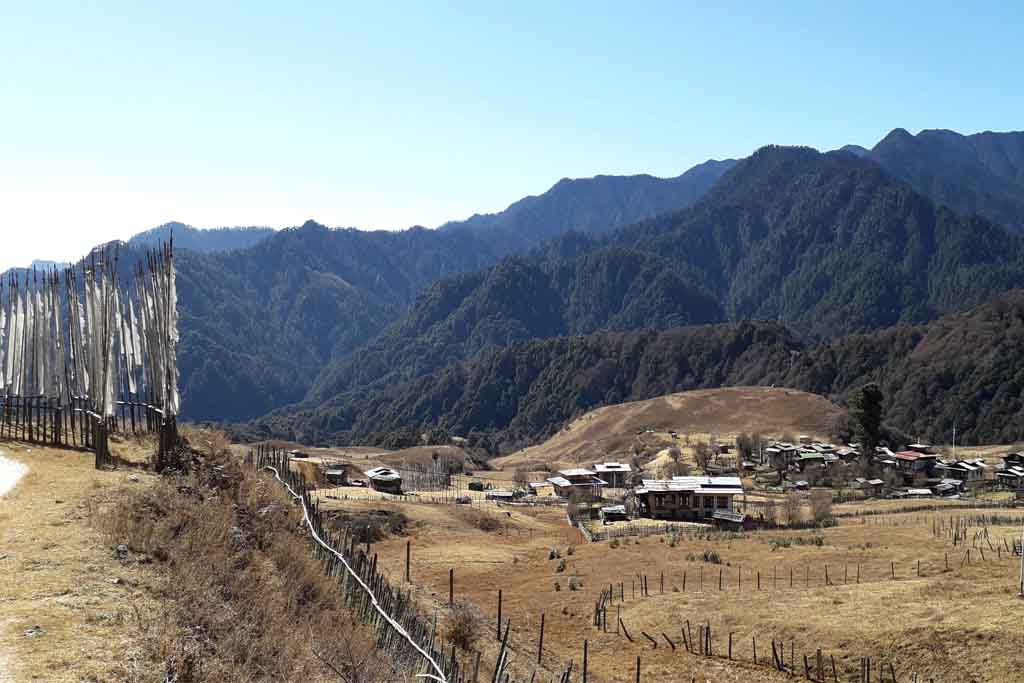
At Senior, where you will spend the night camping/homestay, you will be welcomed with a hot shower, a traditional hot stone spa, and a locally produced organic meal.
Sengor – Latongla
Pay a quick visit to the Sengor Lhakhang (temple), which is thought to be hundreds of years old, after breakfast at camp. Some people think that the First Patseling Trulku Drubtob Namgyel Lhundrub constructed it at some point in the 18th century.
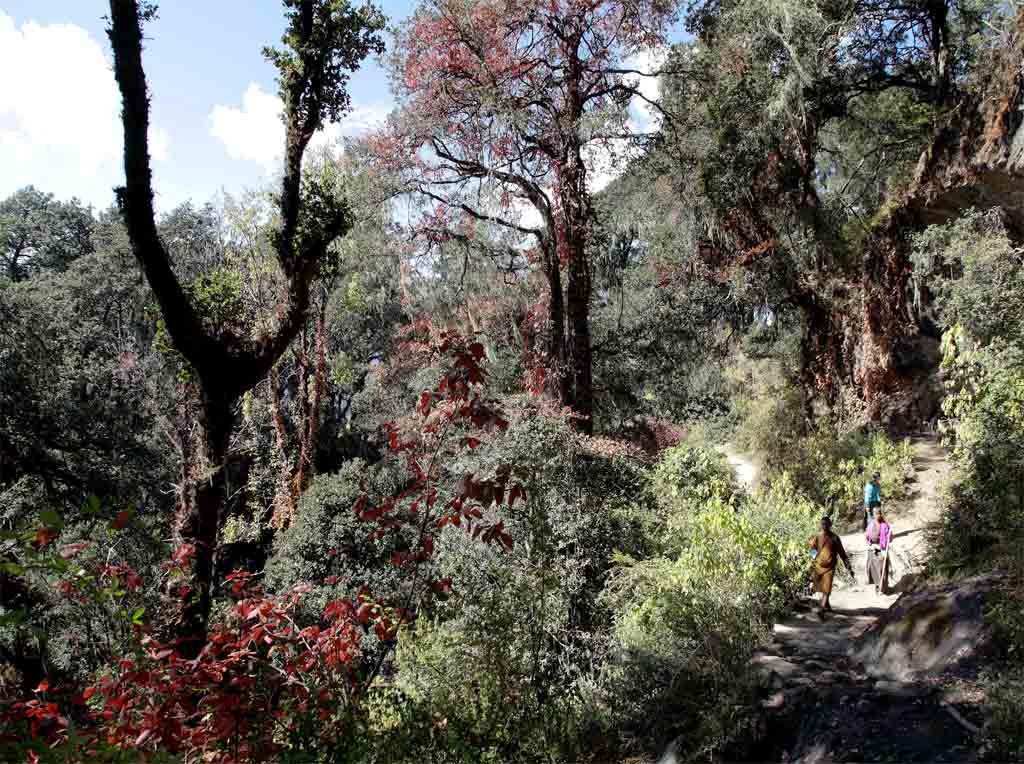
As you travel to Latongla from Sengor, descend the steep hill into the Valley while navigating through an area of extensive vegetation.
The Trail’s current portion offers a unique opportunity to marvel at Bhutan’s diversity and natural beauty as it travels through a wide range of plants. The distant Namling waterfall will be audible to you for most of the day.
At the campsite, your crew will greet you and encourage you to have a hot shower, a traditional hot stone bath, and eat an organic dinner made with locally sourced ingredients. You will enjoy the night camping at Latonga.
Latongla – Lingmithang
Rejoin the Trail for a steep drop through woodland after breakfast at camp. As a recall of a time when the Trail would have been busy with traders, pilgrims, and messengers, many sections of the descent employ dry stone steps built by the predecessors. Over a distance of 10 kilometers (6.21 miles), you may anticipate a vertical decline of about 2 kilometers (1.25 miles), and you’ll feel the air warming up as you go.
The Trail also goes via the breathtakingly ethereal ruins of Zhongar Dzong (fortress). The Dzong was supposedly cursed by its builder, Zochhen Bala, leading to its demise. The King is claimed to have had Bala killed out of concern that he could try to copy the design he had ordered elsewhere. However, Bala is said to have been reincarnated as a serpent of evil that resides beneath the fortress’s foundations. The Dzong was most likely destroyed by fire and an earthquake that is claimed to have lasted days.
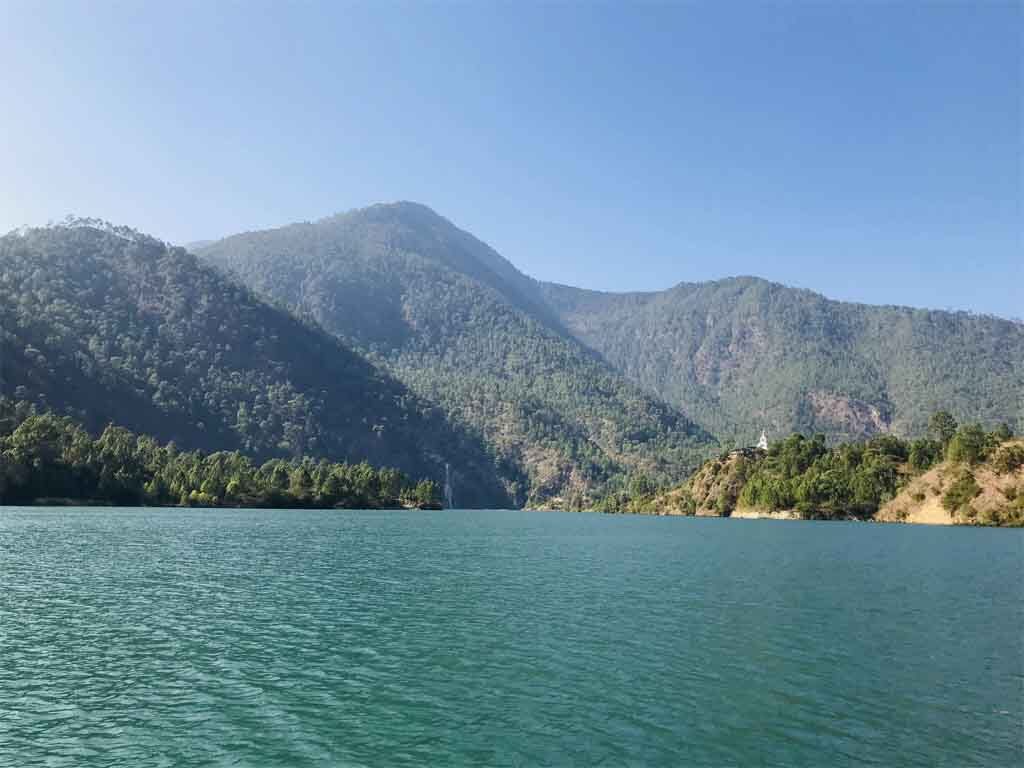
At Lingmithang, where you will spend the night camping, your team will welcome you with a hot shower, a traditional hot stone bath, & a locally produced organic dinner.
Lingmithang- Mongar
After breakfast, move toward the town of Mongar in the east. It will follow the East-West highway most of the morning to the Kuri River. The Trail then turns back into a thick forest and ascends abruptly toward Mongar from Kuri Zampa.
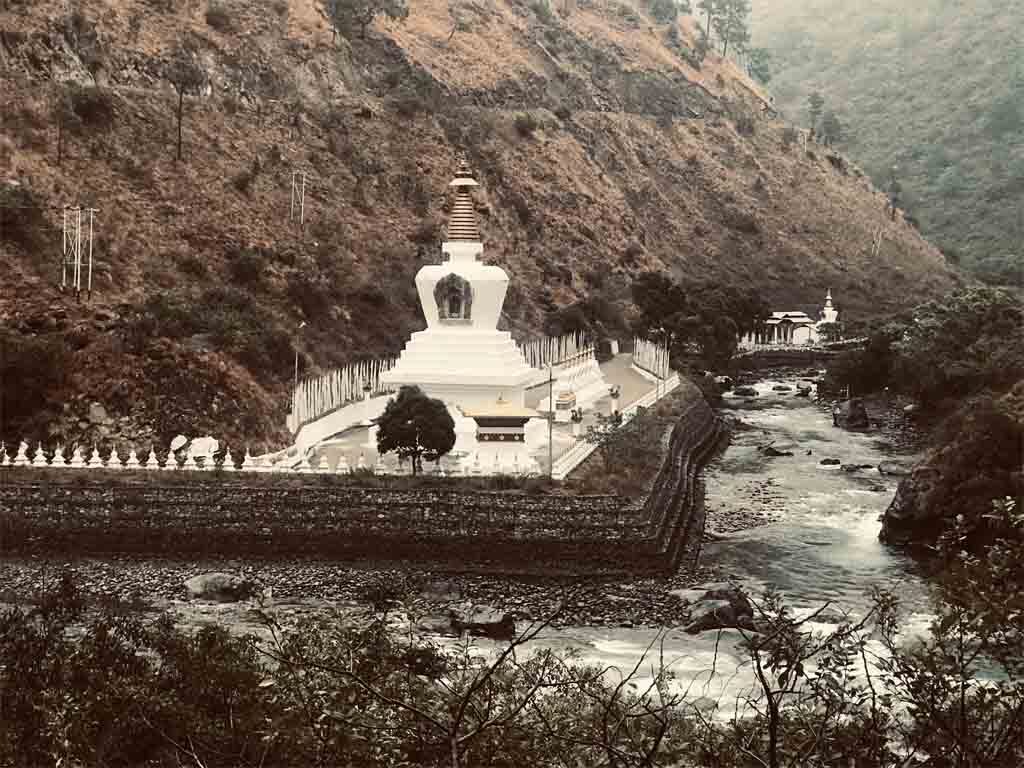
Visit the Mongar Dzong (fortress), the city’s most commanding feature, as soon as you arrive. The 1930-built structure houses both the monastic body and the district’s administrative offices. A monastery inside the Dzong offers lodging, food, and the chance to further one’s spiritual education to young monks, especially those from rural areas.
Afterward, check your accommodation before going to a restaurant for supper with your guide.
Mongar – Korila
After breakfast at your accommodation, leave Mongar and continue east toward Ngatshang. You’ll spend today ascending the Korila Pass and travelling via the towns of Wengkhar and Themdangbi.
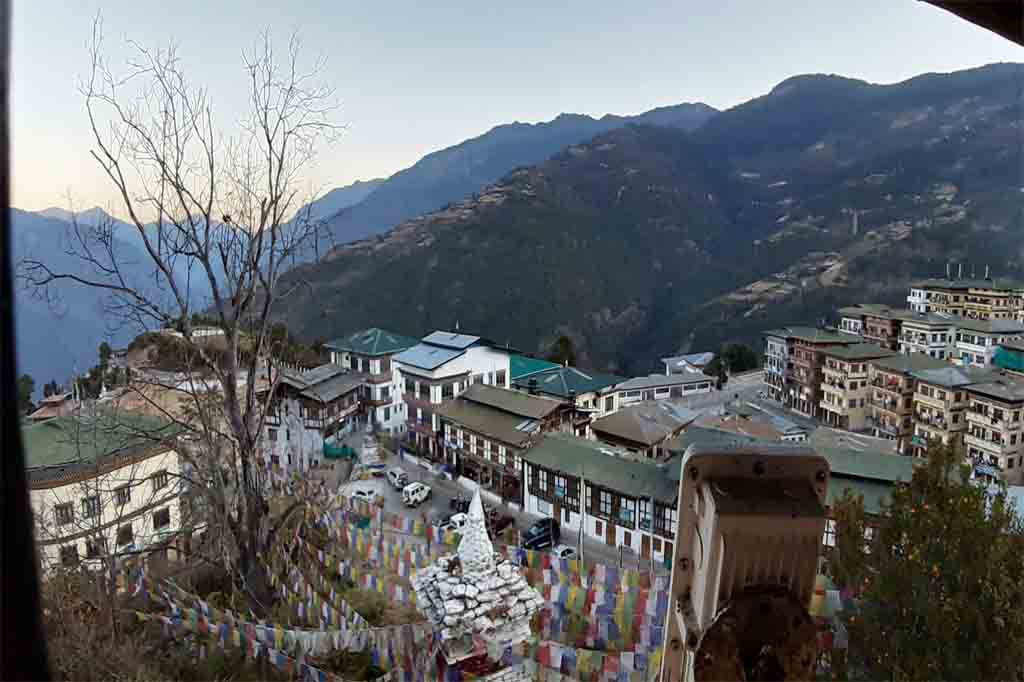
Stop at Wadipa Nye, a sacred site near the pass in Korila, for a picnic meal. This place hosts an annual event where villagers put their hands beneath a rock in hopes of finding animal fur; if they do, it is said it would bless them with enormous wealth. Here is a statue of Guru Rinpoche to mark the location where, in the seventh century, a cow herder saw Guru doing meditation and gave him milk.
You will camp close to Korila tonight; when you get there, your crew will welcome you to have a hot shower, a traditional hot stone bath, and eat an organic dinner made with locally sourced ingredients.
Korila – Sherizampa
After having breakfast at camp, re-join the Trail and follow it as it descends toward Ngatshang, where you can later see the Jarong Khasor Stupa. Then, continue moving east while descending through subtropical forests until you reach the Sherizampa settlement. Some villagers think that the spiritual impurities of the Trashigang Dzongpon’s dead body, which rested on the stupa on its route back to Trashigang to be buried, created a bend in the stupa’s first base floor.
Upon reaching Sherizampa, proceed to your campground, where your group will welcome you to unwind with a hot shower, a traditional hot stone bath, and a great, organic dinner.
Sherizampa – Drametse
Follow the Trail as it rises back up through pine forests, lemongrass, and along ridges with beautiful vistas after breakfast at camp by crossing the aging suspension bridge.
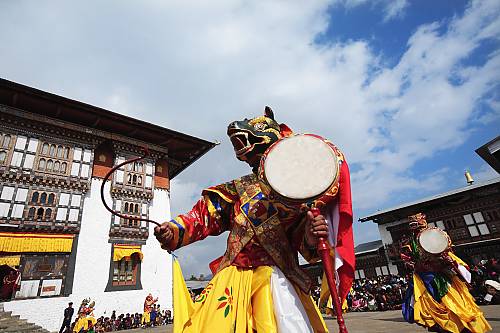
The Trail gradually rises from Baginla, where you will stop for lunch, to Drametse. Visit the Drametse Lhakhang (temple), which was short-cut by Ani Cheten Zangmo, Terton Pema Lingpa’s granddaughter, in the 16th century. Ani Cheten Zangmo discovered this location suitable for meditation after leaving Bumthang to reject a local king’s marriage proposal. The name Drametse means “the peak without adversaries” in Greek. Drametse is the principal residence of Terton Pema Lingpa’s lineage and the center of eastern Bhutan’s religious and cultural life.
Enjoy the evening in a traditional farmhouse with a local Bhutanese family. You will eat a traditional Bhutanese lunch that your hosts will make for you while seated on the floor, as is the standard in Bhutanese houses.
Drametse –Gongthung
Take the Trail again as it descends steeply from Drametse past the settlement of Bazur, where you will see the Bazur Lhakhang after breakfast with your hosts (temple). The temple was converted back into a temple at the request of one of the staff members after it had previously been used to store royal grain supplies before His Majesty the Third King of Bhutan.
After leaving Bazur, the Trail ascends a prodigious ridge until it reaches Narang, where you will pause for lunch.
Follow the Trail via the village of Durung, located on the border of the Mongar and Trashingang districts, from Narang.
After crossing the river, pay a quick visit to Dongnga Choeling’s communal temple. The Trail then ascends farther in the direction of Gongthung.
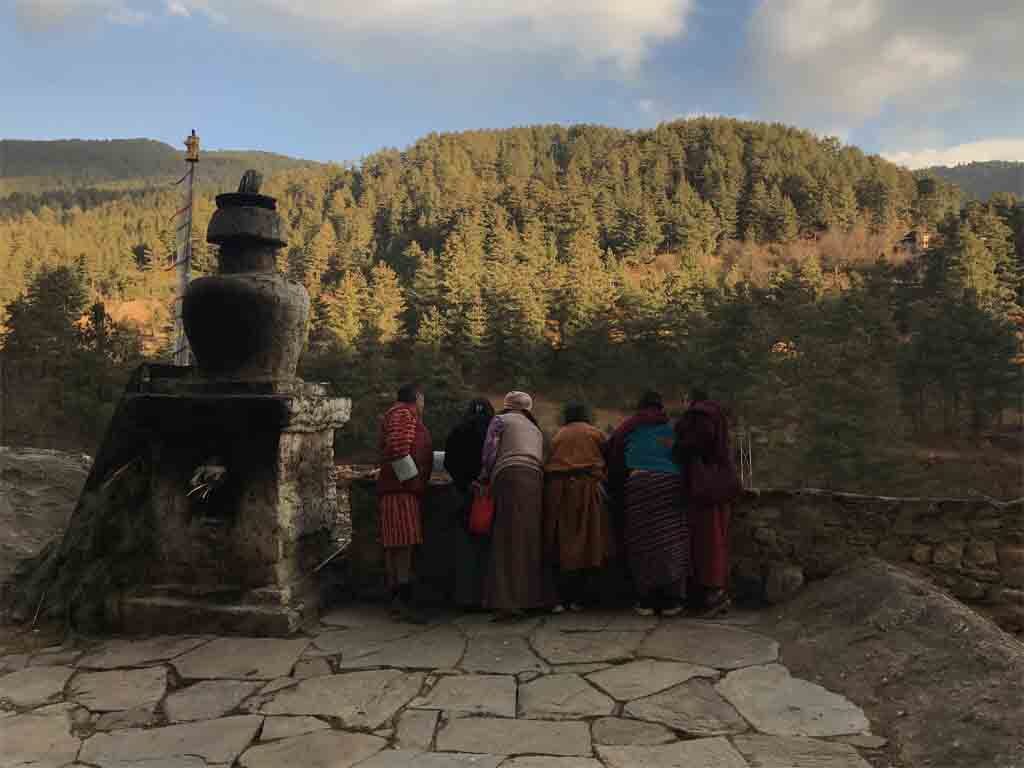
Visit the Jarong Khashor Stupa when you arrive in Gongthung. This stupa was constructed during the visit of a lama who travelled all the distance from Pemakhue (now the Indian state of Arunachal Pradesh).
Now, return to the campsite where your team will welcome you to unwind with a hot shower, a classic hot stone bath, and a delectable, organic dinner.
Conclusion
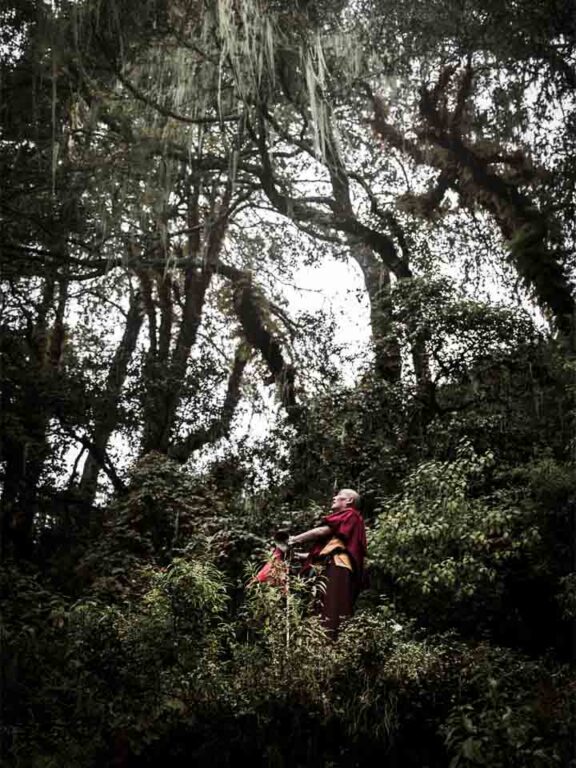
There are few places in the world that can be considered ‘untouched’ by modernity. The ages of exploration and frontier-ism have truly come close , as destination such as Antarctica & Mt. Everest have been unlocked , ready to be conquered by the common tourist. However a new wave of experiential travels have emerged in which traveler seek more than the bucket lists of ‘first’ , and to connect intimately with a location. Such an experience looks to engage the people , the culture, the environment, and relationship that place has to offer. Bhutan has become a prime travel destination and opening of trans Bhutan trail is an attempt to incorporate the experiential, while also maintaining an aura of exclusivity.
If not all , at least you should try to incorporate one or two trans Bhutan trail section in your Bhutan Itinerary . So you may get the taste of exclusive Bhutan. For more information on Trans Bhutan Trail , Contact Us.
Frequently Asked Questions (FAQs)
- What is the total length of the Trans Bhutan Trail?
- The Trans Bhutan Trail spans a total distance of 403 kilometers, connecting various villages and towns from Haa in the west to Trashigang in the east.
- How long does it take to complete the entire Trans Bhutan Trail?
- The complete Trans Bhutan Trail takes approximately 36 days to cover. However, it can also be explored in parts, allowing for shorter durations.
- What is the level of difficulty for the Trans Bhutan Trail?
- The trail offers a range of difficulty levels, from easy to challenging. Some sections are relatively moderate, while others are considered to be among the most challenging routes in the world.
- Are there amenities available along the Trans Bhutan Trail?
- Yes, amenities such as toilets and resting areas have been installed along the route. Additionally, there are around 130 sustainable marker poles with QR Codes that provide information about specific places when scanned.
- What are some of the highlights of the Trans Bhutan Trail?
- Highlights of the trail include panoramic views of valleys, visits to ancient temples and Dzongs, opportunities to interact with locals, experience traditional Bhutanese activities, and witness the rich natural beauty of Bhutan’s landscapes.
Taggedtrans bhutan trailvillage walk


